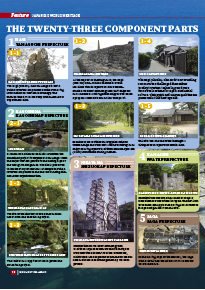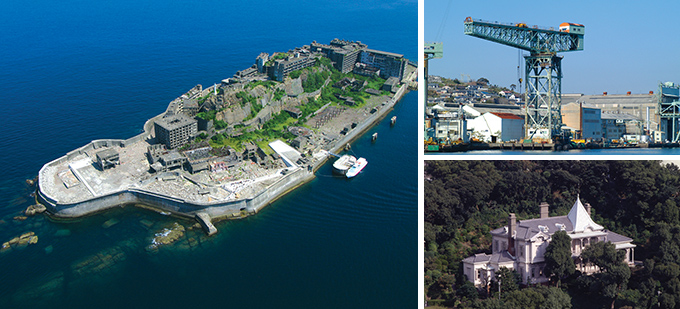Home > Highlighting JAPAN >Highlighting Japan September 2015>Japanese World Heritage
Highlighting JAPAN

Japanese World Heritage
The Twenty-Three Component Parts

《1 Hagi》Yamaguchi Prefecture
1-1 Hagi Reverberatory Furnace
The Hagi (Choshu) Clan challenged itself to build a reverberatory furnace on its own using information on Western technology. The furnace tells a valuable story of trial-and-error experimentation.
1-2 Ebisugahana Shipyard
At the request of the shogunate the Hagi (Choshu) Clan—which controlled several locations vital to Japan’s coastal defense—studied Western technology and built ships for naval defense at Ebisugahana Shipyard based on a proposal from statesman Kido Takayoshi.
1-3 Ohitayama Tatara Iron Works
Remains of the facilities that supplied nails for wooden ships and other metal items to Ebisugahana Shipyard using Japan’s traditional bellows-operated (tatara) iron manufacturing method.
1-4 Hagi Castle Town
The Hagi (Choshu) Clan and its surrounding communities challenged themselves to adopt Western technology and were formative locations for Japan’s industrial culture. Their spirit and unique qualities are preserved at this heritage site.
1-5 Shokasonjuku Academy
This site became one of the ideological birthplaces of Japan’s modernization.
《2 Kagoshima》Kagoshima Prefecture
2-1 Former Shuseikan
Satsuma lord Shimazu Nariakira launched the Shuseikan project in response to challenges from the major Western powers in the closing days of the Tokugawa Shogunate. The site is preserved to tell the story of Satsuma’s attempts to build a reverberatory furnace and the surrounding trial-and-error experimentation.
2-2 Terayama Charcoal Kiln
The site of the kiln that created the charcoal used to fuel the Shuseikan project.
2-3 Sekiyoshi Sluice Gate of Yoshino Leat
The sluice that supplied water to power the Shuseikan project.
《3 Nirayama》Shizuoka Prefecture
3-1 Nirayama Reverberatory Furnaces
Information on Western technology and traditional Japanese construction techniques were combined to construct these furnaces, which were used to produce cannons for coastal defense in the face of antagonism by Western powers.
《4 Kamaishi》Iwate Prefecture
4-1 Hashino Iron Mining and Smelting Site
Kamaishi was one of a small number areas where iron ore was excavated in Japan. The first iron to be successfully produced using a blast furnace in Japan originated from this site.
《5 Saga》Saga Prefecture
5-1 Mietsu Naval Dock
In the closing days of the Edo Era, the Saga Clan established the Mietsu Naval Dock for coastal defense.
《6 Nagasaki》Nagasaki Prefecture
6-1 Kosuge Slip Dock
Japan’s first Western-style slipway, equipped with a steam-powered winch, is still in existence today. In 1869, this ship repair facility was established at Nagasaki Port through collaboration between Scottish merchant Thomas Glover and the Satsuma Clan.
6-2 Mitsubishi No. 3 Dry Dock
This dry dock, constructed from 1901 to 1905, was used to repair large ships constructed during Mitsubishi’s limited-partnership era.
6-3 Mitsubishi Giant Cantilever Crane
This was Japan’s first electric crane, constructed in 1909 during Mitsubishi’s limited-partnership era in conjunction with the electrification of the shipyard.
6-4 Mitsubishi Former Pattern Shop
Built in 1898 to produce wooden patterns for castings, this pattern shop was constructed during Mitsubishi’s limited-partnership era in response to the increased demand in Japan for cast-metal goods.
6-5 Mitsubishi Senshokaku Guest House
Overlooking the third dock from the hillside, this Western-style, two-story wooden house was built during Mitsubishi’s limited-partnership era in the formative years of Japan’s shipbuilding industry. Although completed in 1904 as the residence of Heigoro Shoda, head of Nagasaki Shipyard, it was used as a reception hall rather than a private home.
6-6 Takashima Coal Mine
From the closing days of the Tokugawa Shogunate to the Meiji Era, the demand for coal in Japan increased greatly in order to power Western machinery. On Takashima Island off the coast of Nagasaki, the Saga Clan, together with Scottish merchant Thomas Glover, developed a coal mine.
6-7 Hashima Coal Mine
Hashima Coal Mine was an island coal mine developed using technology from Takashima Coal Mine.
6-8 Glover House and Office
The base of operations for Scottish merchant Thomas Glover, who assisted in Japan’s industrialization.
《7 Miike》Fukuoka Prefecture and Kumamoto Prefecture
7-1 Miike Coal Mine and Miike Port
Miike Coal Mine is now closed, but traces of the private railroad connecting the mine’s main pits, Miyanohara and Manda, with the mine’s shipping port Miike Port, remain.
7-2 Misumi West Port
Designed by Dutch engineer A. Rouwenhorst Mulder, this port was constructed with government subsidies and became one of the Meiji Era’s three biggest harbor construction projects.
《8 Yawata》Fukuoka Prefecture
8-1 The Imperial Steel Works, Japan
The First Head Office is in a symmetrical edifice rendered in red brick with a dome at its center. The German firm Gutehoffnungshütte Co. (GHH) designed and provided the steel frame for the steel works’ Repair Shop, where machinery was repaired and components manufactured for the steel works. The Repair Shop has been in continuous operation for over 110 years. GHH also designed and provided the steel frame for the Former Forge Shop, which manufactured the forged products needed to construct the steel works.
8-2 Onga River Pumping Station
A pumping facility that transported water from the mouth of the Onga River to the Imperial Steel Works about ten kilometers away. The facility is still operational today.
© 2009 Cabinet Office, Government of Japan






